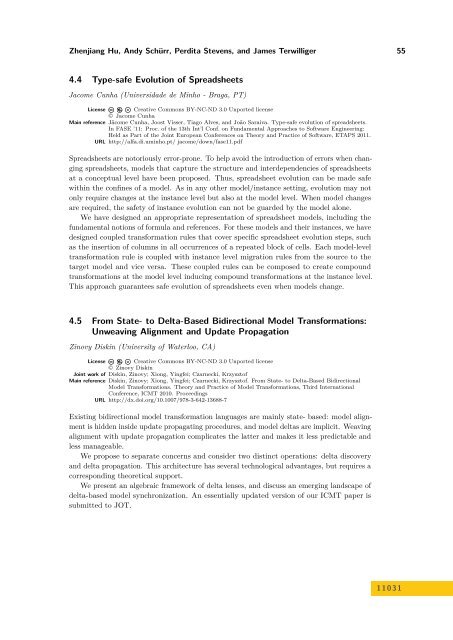Volume 1, Issue 1, January 2011 - DROPS - Schloss Dagstuhl
Volume 1, Issue 1, January 2011 - DROPS - Schloss Dagstuhl
Volume 1, Issue 1, January 2011 - DROPS - Schloss Dagstuhl
Create successful ePaper yourself
Turn your PDF publications into a flip-book with our unique Google optimized e-Paper software.
Zhenjiang Hu, Andy Schürr, Perdita Stevens, and James Terwilliger 55<br />
4.4 Type-safe Evolution of Spreadsheets<br />
Jacome Cunha (Universidade de Minho - Braga, PT)<br />
License Creative Commons BY-NC-ND 3.0 Unported license<br />
© Jacome Cunha<br />
Main reference Jãcome Cunha, Joost Visser, Tiago Alves, and João Saraiva. Type-safe evolution of spreadsheets.<br />
In FASE ’11: Proc. of the 13th Int’l Conf. on Fundamental Approaches to Software Engineering:<br />
Held as Part of the Joint European Conferences on Theory and Practice of Software, ETAPS <strong>2011</strong>.<br />
URL http://alfa.di.uminho.pt/ jacome/down/fase11.pdf<br />
Spreadsheets are notoriously error-prone. To help avoid the introduction of errors when changing<br />
spreadsheets, models that capture the structure and interdependencies of spreadsheets<br />
at a conceptual level have been proposed. Thus, spreadsheet evolution can be made safe<br />
within the confines of a model. As in any other model/instance setting, evolution may not<br />
only require changes at the instance level but also at the model level. When model changes<br />
are required, the safety of instance evolution can not be guarded by the model alone.<br />
We have designed an appropriate representation of spreadsheet models, including the<br />
fundamental notions of formula and references. For these models and their instances, we have<br />
designed coupled transformation rules that cover specific spreadsheet evolution steps, such<br />
as the insertion of columns in all occurrences of a repeated block of cells. Each model-level<br />
transformation rule is coupled with instance level migration rules from the source to the<br />
target model and vice versa. These coupled rules can be composed to create compound<br />
transformations at the model level inducing compound transformations at the instance level.<br />
This approach guarantees safe evolution of spreadsheets even when models change.<br />
4.5 From State- to Delta-Based Bidirectional Model Transformations:<br />
Unweaving Alignment and Update Propagation<br />
Zinovy Diskin (University of Waterloo, CA)<br />
License Creative Commons BY-NC-ND 3.0 Unported license<br />
© Zinovy Diskin<br />
Joint work of Diskin, Zinovy; Xiong, Yingfei; Czarnecki, Krzysztof<br />
Main reference Diskin, Zinovy; Xiong, Yingfei; Czarnecki, Krzysztof. From State- to Delta-Based Bidirectional<br />
Model Transformations. Theory and Practice of Model Transformations, Third International<br />
Conference, ICMT 2010. Proceedings<br />
URL http://dx.doi.org/10.1007/978-3-642-13688-7<br />
Existing bidirectional model transformation languages are mainly state- based: model alignment<br />
is hidden inside update propagating procedures, and model deltas are implicit. Weaving<br />
alignment with update propagation complicates the latter and makes it less predictable and<br />
less manageable.<br />
We propose to separate concerns and consider two distinct operations: delta discovery<br />
and delta propagation. This architecture has several technological advantages, but requires a<br />
corresponding theoretical support.<br />
We present an algebraic framework of delta lenses, and discuss an emerging landscape of<br />
delta-based model synchronization. An essentially updated version of our ICMT paper is<br />
submitted to JOT.<br />
1 1 0 3 1













